Abstract
The extremely year-to-year variable production of seeds (masting) is an extended plant reproductive behaviour important for forest dynamics and food webs. The dependence of these episodes of massive seed production on recently or long-term photosynthesised carbohydrates, however, remains controversial. In this paper, we explore whether vegetation (tree canopy) changes, detected using EVI as a proxy of leaf area and photosynthetic capacity, can provide a reliable estimation of seed production. To complete this analysis, we also explored the effect of weather both in the trends of EVI and in acorn crop size. To this end, we compared the trends of the EVI and acorn production over 10 years (2000–2009) in five stands of Quercus ilex L. in Barcelona (Catalonia, NE Spain). We found that acorn production was mainly driven by a combination of: (i) a minimum initial threshold in the EVI values, (ii) an increase in EVI in the 9 ± 4 months prior to reproduction, and (iii) appropriate weather conditions (low water stress) during spring. These results indicated, apparently for the first time, that reproduction in masting species could be detected and partly predicted by remotely sensed vegetative indices. Our results suggested that this particular reproductive behaviour in Mediterranean oaks was driven by a combination of two factors, i.e. good and improving vegetation conditions, as shown by a minimum initial threshold and the increase in EVI needed for large seed crops, and the need of wet weather conditions during spring. Moreover, our results fully supported recent studies that have associated short-term photosynthate production with seed production.



Similar content being viewed by others
References
Abrahamson W, Layne J (2002) Relation of ramet size to acorn production in five oak species of xeric upland habitats in south-central Florida. Am J Bot 89:124–131
Alla AQ, Camarero JJ, Maestro-Martínez M, Montserrat-Martí G (2011) Acorn production is linked to secondary growth but not to declining carbohydrate concentrations in current-year shoots of two oak species. Trees 26:841–850. doi:10.1007/s00468-011-0658-3
Bates D, Maechler M, Bolker B, Walker S (2013) lme4: linear mixed-effects models using Eigen and S4
Beguería S, Vicente-serrano SM (2012) SPEI: calculation of the standardised precipitation-evapotranspiration index. R package version 1.1
Camarero JJ, Albuixech J, López-Lozano R, Casterad MA, Montserrat-Martí G (2010) An increase in canopy cover leads to masting in Quercus ilex. Trees 24:909–918. doi:10.1007/s00468-010-0462-5
Cleveland WS (1979) Robust locally weighted regression and smoothing scatterplots. J Am Stat Assoc 74:829–836. doi:10.1080/01621459.1979.10481038
Core Team R (2013) R: a language and environment for statistical computing. R Found Stat Comput 1:409
Efron B (1987) Better bootstrap confidence intervals. J Am Stat Assoc 82:171–185
Espelta JM, Cortés P, Molowny-horas R, Sánchez-humanes B, Retana J (2008) Masting mediated by summer drought reduces acorn predation in Mediterranean oak forests. Ecology 89:805–817
Espelta JM, Cortés P, Molowny-Horas R, Retana J (2009) Acorn crop size and pre-dispersal predation determine inter-specific differences in the recruitment of co-occurring oaks. Oecologia 161:559–568. doi:10.1007/s00442-009-1394-x
Fensholt R, Sandholt I, Rasmussen MS (2004) Evaluation of MODIS LAI, fAPAR and the relation between fAPAR and NDVI in a semi-arid environment using in situ measurements. Remote Sens Environ 91:490–507. doi:10.1016/j.rse.2004.04.009
Fernández-Martínez M, Belmonte J, Maria Espelta J, Espelta JM (2012) Masting in oaks: disentangling the effect of flowering phenology, airborne pollen load and drought. Acta Oecol 43:51–59. doi:10.1016/j.actao.2012.05.006
Fernández-Martínez M, Vicca S, Janssens IA, Luyssaert S, Campioli M, Sardans J, Estiarte M, Peñuelas J (2014) Spatial variability and controls over biomass stocks, carbon fluxes and resource-use efficiencies in forest ecosystems. Trees Struct Funct 28:597–611. doi:10.1007/s00468-013-0975-9
Ferretti M, Baratozzi L, Cenni E, Cozzi A, Savini P (1998) Crown transparency of beech (Fagus sylvatica L.) in the Northern Appennines (Italy)—status, changes and relationships with site characteristics and other indices of tree condition. Chemosphere 36:1037–1042. doi:10.1016/S0045-6535(97)10168-0
Garbulsky MF, Peñuelas J, Papale D, Filella I (2008) Remote estimation of carbon dioxide uptake by a Mediterranean forest. Glob Chang Biol 14:2860–2867. doi:10.1111/j.1365-2486.2008.01684.x
Garbulsky MF, Peñuelas J, Ogaya R, Filella I (2013) Leaf and stand-level carbon uptake of a Mediterranean forest estimated using the satellite-derived reflectance indices EVI and PRI. Int J Remote Sens 34:1282–1296. doi:10.1080/01431161.2012.718457
Gower STG, Rankina OK, Olson RJO, Apps MA, Inder SL (2001) Net primary production and carbon allocation patterns. Ecol Appl 11:1395–1411
Gross HL (1972) Crown deterioration and reduced growth associated with excessive seed production by birch. Can J Bot 50:2431–2437. doi:10.1139/b72-312
Han Q, Kabeya D, Iio A, Kakubari Y (2008) Masting in Fagus crenata and its influence on the nitrogen content and dry mass of winter buds. Tree Physiol 28:1269–1276. doi:10.1093/treephys/28.8.1269
Herrera C, Jordano P, Guitián J, Traveset A (1998) Annual variability in seed production by woody plants and the masting concept: reassessment of principles and relationship to pollination and seed dispersal. Am Nat 152:576–594
Hoch G, Siegwolf RTW, Keel SG, Körner C, Han Q (2013) Fruit production in three masting tree species does not rely on stored carbon reserves. Oecologia 171:653–662. doi:10.1007/s00442-012-2579-2
Huete A, Didan K, Miura T, Rodriguez E, Gao X, Ferreira L (2002) Overview of the radiometric and biophysical performance of the MODIS vegetation indices. Remote Sens Environ 83(1):195–213. doi:10.1016/S0034-4257(02)00096-2
Ichie T, Igarashi S, Yoshida S (2013) Are stored carbohydrates necessary for seed production in temperate deciduous trees? J Ecol 101:525–531. doi:10.1111/1365-2745.12038
Innes JL (1992) Observations on the condition of beech (Fagus sylvatica L.) in Britain in 1990. Forestry 65:35–60. doi:10.1093/forestry/65.1.35
Isagi Y, Sugimura K, Sumida A, Ito H (1997) How does masting happen and synchronize? J Theor Biol 187:231–239. doi:10.1006/jtbi.1997.0442
Jarvis P, Rey A, Petsikos C, Wingate L, Rayment M, Pereira J, Banza J, David J, Miglietta F, Borghetti M, Manca G, Valentini R (2007) Drying and wetting of Mediterranean soils stimulates decomposition and carbon dioxide emission: the “Birch effect”. Tree Physiol 27:929–940. doi:10.1093/treephys/27.7.929
Jensen JLW (1905) Sur les fonctions convexes et les inégalités entre les valeurs moyennes. Acta Math 30:175–193
Kelly D, Sork VL (2002) Mast seeding in perennial plants: why, how, where? Annu Rev Ecol Syst 33:427–447. doi:10.1146/annurev.ecolsys.33.020602.095433
Kelly D, Geldenhuis A, James A, Penelope Holland E, Plank MJ, Brockie RE, Cowan PE, Harper GA, Lee WG, Maitland MJ, Mark AF, Mills JA, Wilson PR, Byrom AE (2013) Of mast and mean: differential-temperature cue makes mast seeding insensitive to climate change. Ecol Lett 16:90–98. doi:10.1111/ele.12020
Koenig W, Knops J (2000) Patterns of annual seed production by northern hemisphere trees: a global perspective. Am Nat 155:59–69. doi:10.1086/303302
Koenig W, Knops J (2005) The mystery of masting in trees. Am Sci 93:340–347. doi:10.1511/2005.54.970
Kramer K, Leinonen I, Loustau D (2000) The importance of phenology for the evaluation of impact of climate change on growth of boreal, temperate and Mediterranean forests ecosystems: an overview. Int J Biometeorol 44:67–75
Law BE, Falge E, Gu L, Baldocchi DD, Bakwin P, Berbigier P, Davis K, Dolman AJ, Falk M, Fuentes JD, Goldstein A, Granier A, Grelle A, Hollinger D, Janssens IA, Jarvis P, Jensen NO, Katul G, Mahli Y, Matteucci G, Meyers T, Monson R, Munger W, Oechel W (2002) Environmental controls over carbon dioxide and water vapor exchange of terrestrial vegetation. Agric For Meteorol 113:97–120
McKone MJ, Kelly D, Lee WG (1998) Effect of climate change on mast-seeding species : frequency of mass flowering and escape from specialist insect seed predators. Glob Chang Biol 4:591–596
McShea W (2000) The influence of acorn crops on annual variation in rodent and bird populations. Ecology 81:228–238
Myneni RB, Hoffman S, Knyazikhin Y, Privette JL, Glassy J, Tian Y, Wang Y, Song X, Zhang Y, Smith GR, Lotsch A, Friedl M, Morisette JT, Votava P, Nemani RR, Running SW (2002) Global products of vegetation leaf area and fraction absorbed PAR from year one of MODIS data. Remote Sens Environ 83:214–231. doi:10.1016/S0034-4257(02)00074-3
Negi ASS, Negi GCSCS, Singh SPP (1996) Establishment and growth of Quercus floribunda seedlings after a mast year. J Veg Sci 7:559–564. doi:10.2307/3236305
Norton DA, Kelly D (1988) Mast seeding over 33 years by Dacrydium cupressinum Lamb. (rimu) (Podocarpaceae) in New Zealand: the importance of economies of scale. Funct Ecol 2:399–408
Ogaya R, Llusià J, Barbeta A, Asensio D, Liu D, Alessio GA, Peñuelas J (2014) Foliar CO2 in a holm oak forest subjected to 15 years of climate change simulation. Plant Sci 226:101–107. doi:10.1016/j.plantsci.2014.06.010
Ogaya R, Barbeta A, Başnou C, Peñuelas J (2015) Satellite data as indicators of tree biomass growth and forest dieback in a Mediterranean holm oak forest. Ann For Sci 72:135–144. doi:10.1007/s13595-014-0408-y
Ostfeld RS (1997) The ecology of Lyme-disease risk. Am Sci 85:338–346
Ostfeld R, Keesing F (2000) Pulsed resources and community dynamics of consumers in terrestrial ecosystems. Trends Ecol Evol 15:232–237
Ranta E, Kaitala V, Lindström J, Helle E (1997) The moran effect and synchrony in population dynamics. Oikos 78:136–142
Ruel JJ, Ayres MP (1999) Jensen’s inequality predicts effects of environmental variation. Trends Ecol Evol 14:361–366. doi:10.1016/S0169-5347(99)01664-X
Sala A, Hopping K, McIntire EJB, Delzon S, Crone EE (2012) Masting in whitebark pine (Pinus albicaulis) depletes stored nutrients. New Phytol 196:189–199. doi:10.1111/j.1469-8137.2012.04257.x
Sánchez-Humanes B (2009) Acorn production and growth in Mediterranean oaks: trade-offs and the role of climate modular organization and phenology. Universitat Autonònoma de Barcelona, Barcelona
Sánchez-Humanes B, Sork VL, Espelta JM (2011) Trade-offs between vegetative growth and acorn production in Quercus lobata during a mast year: the relevance of crop size and hierarchical level within the canopy. Oecologia 166:101–110. doi:10.1007/s00442-010-1819-6
Sardans J, Peñuelas J (2007) Drought changes phosphorus and potassium accumulation patterns in an evergreen Mediterranean forest. Funct Ecol 21:191–201. doi:10.1111/j.1365-2435.2007.01247.x
Shen M, Chen J, Zhu X, Tang Y (2014) Yellow flowers can decrease NDVI and EVI values: evidence from a field experiment in an alpine meadow. Can J Remote Sens 35:99–106. doi:10.5589/m09-003
Smaill SJ, Clinton PW, Allen RB, Davis MR (2011) Climate cues and resources interact to determine seed production by a masting species. J Ecol 99:870–877. doi:10.1111/j.1365-2745.2011.01803.x
Sork VL, Bramble J, Sexton O (1993) Ecology of mast-fruiting in three species of North American deciduous oaks. Ecology 74:528–541
Sprintsin M, Karnieli A, Berliner P, Rotenberg E, Yakir D, Cohen S (2007) The effect of spatial resolution on the accuracy of leaf area index estimation for a forest planted in the desert transition zone. Remote Sens Environ 109:416–428. doi:10.1016/j.rse.2007.01.020
Verbesselt J, Hyndman R, Newnham G, Culvenor D (2010a) Detecting trend and seasonal changes in satellite image time series. Remote Sens Environ 114:106–115. doi:10.1016/j.rse.2009.08.014
Verbesselt J, Hyndman R, Zeileis A, Culvenor D (2010b) Phenological change detection while accounting for abrupt and gradual trends in satellite image time series. Remote Sens Environ 114:2970–2980. doi:10.1016/j.rse.2010.08.003
Vicca S, Balzaloro M, Filella I, Veger A, Zhang C, Peñuelas J, Janssens IA (2014) Drought responses in forests of different leaf type and climate: how do remote sensing indicators reflect field measurements? Global vegetation monitoring and modeling conference, Palais des Papes, Avignon, 07 Feb 2014
Vicente-serrano SM, Beguería S, López-Moreno JI (2010) A multiscalar drought index sensitive to global warming: the standardized precipitation evapotranspiration index. J Clim 23:1696–1718. doi:10.1175/2009JCLI2909.1
Vicente-Serrano SM, Gouveia C, Camarero JJ, Beguería S, Trigo R, López-Moreno JI, Azorín-Molina C, Pasho E, Lorenzo-Lacruz J, Revuelto J, Morán-Tejeda E, Sanchez-Lorenzo A (2013) Response of vegetation to drought time-scales across global land biomes. Proc Natl Acad Sci USA 110:52–57. doi:10.1073/pnas.1207068110
Zhao D, Reddy KR, Kakani VG, Read JJ, Koti S (2007) Canopy reflectance in cotton for growth assessment and lint yield prediction. Eur J Agron 26:335–344. doi:10.1016/j.eja.2006.12.001
Acknowledgments
This research was funded by the projects MCIIN (CGL2008-04847-C02-02 and CGL2013-48074-P) and Consolider-Ingenio Montes (CSD2008-00040), by the Consorci del Parc de Collserola, by Catalan Government Grants FI-2013 and SGR 2014-274, and by the European Research Council Synergy Grant ERC-2013-SyG-610028 IMBALANCE-P. We thank the Royal Academy of Sciences and Arts of Barcelona for providing the meteorological data from the Fabra Observatory.
Author information
Authors and Affiliations
Corresponding author
Additional information
Communicated by Joy Nystrom Mast.
Rights and permissions
About this article
Cite this article
Fernández-Martínez, M., Garbulsky, M., Peñuelas, J. et al. Temporal trends in the enhanced vegetation index and spring weather predict seed production in Mediterranean oaks. Plant Ecol 216, 1061–1072 (2015). https://doi.org/10.1007/s11258-015-0489-1
Received:
Accepted:
Published:
Issue Date:
DOI: https://doi.org/10.1007/s11258-015-0489-1




